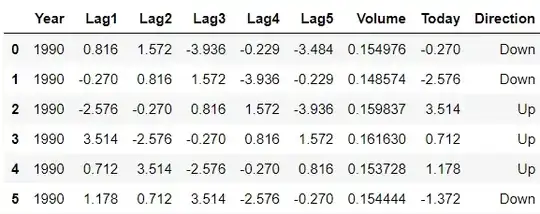I'm calculating Logistic Regression for a purticular dataset and kind of lost while estimating parameters with likelihood function. I stuck when I tried to match my dataset to the formulas below. I found 2 versions of likelihood function - when $y_i$ is Binomial and $y_i$ is Bernoulli distributed.
\begin{equation} L(\beta|y)={\displaystyle \prod_{i=1}^{N} \frac{n_i!} {y_i!(n_i-y_i)!}} \pi_{i}^{y_i}(1-\pi_i)^{n_i - y_i} \tag 1 \end{equation}
and
\begin{equation} L(\beta_0,\beta_1)= \displaystyle \prod_{i=1}^{N}p(x_i)^{y_i}(1-p(x_i))^{1-y_i} \tag 2 \end{equation}
Sources:
- First: https://czep.net/stat/mlelr.pdf (page 3 equ. 2)
- Second: http://www.stat.cmu.edu/~cshalizi/uADA/12/lectures/ch12.pdf (page 5 equ. 12.6)
I'm using dataset from An Introduction To Statistical Learning, by Hastie. Weekly dataset.
https://www.statlearning.com/resources-first-edition
I want to get understanding of what is what in the formulas matching every member of formulas to some piece of information from the dataset.
- Binomial case:
$ N = 6 $ - is number of observarions(I thought it should be equal to number of rows but there is $n_i$);
$ n_i = 6 $ - number of rows;
$ y_i = 3 $ - number of successes/Up's in my dataset;
$ \pi_i = \frac{1}{1+exp(-(\sum_{k=0}^K x_{ik}\beta_k))} $ - probability of 1 success/Direction Up;
$ \pi_i - 1 $ - probability of 1 failure/Direction Down;
We have $ \pi_i^3 $ because we have three rows with success case;
We have $ (\pi_i-1)^{(6-3)} $ because we have three rows with failure case;
$ \frac{n_i!}{y_i!(n_i-y_i)} $ - this is number of combinations to get 3 successes with 6 trials.
My questions here:
A. Could you please explain why is $\prod_{i=1}^{N}$ used here and when it is usefull? Or what is the example of dataset when we need to find a products of the product $\frac{n_i!} {y_i!(n_i-y_i)!} \pi_{i}^{y_i}(1-\pi_i)^{n_i - y_i}$
B. What is gonna be N in scope of my dataset?\
Updated
2. Bernoulli case:
As far as I undertand $N $ - is number of rows in my dataset. So that formula can be expanded like
$$L(\beta_0,\beta_1)= \displaystyle \prod_{i=1}^{6}p(x_i)^{y_i}(1-p(x_i))^{1-y_i} = $$ $$p(x_0)^{0}(1-p(x_0))^{1} * p(x_1)^{0}(1-p(x_1))^{1} * p(x_2)^{1}(1-p(x_2))^{0} * p(x_3)^{1}(1-p(x_3))^{0} * p(x_4)^{1}(1-p(x_4))^{0} * p(x_5)^{0}(1-p(x_5))^{1} = $$
$$p(x_i)^{3}(1-p(x_i))^{3} $$ assuming that $x_0=x_1=...=x_i$
Is this right way to calculate that formula for Weekly dataset?
